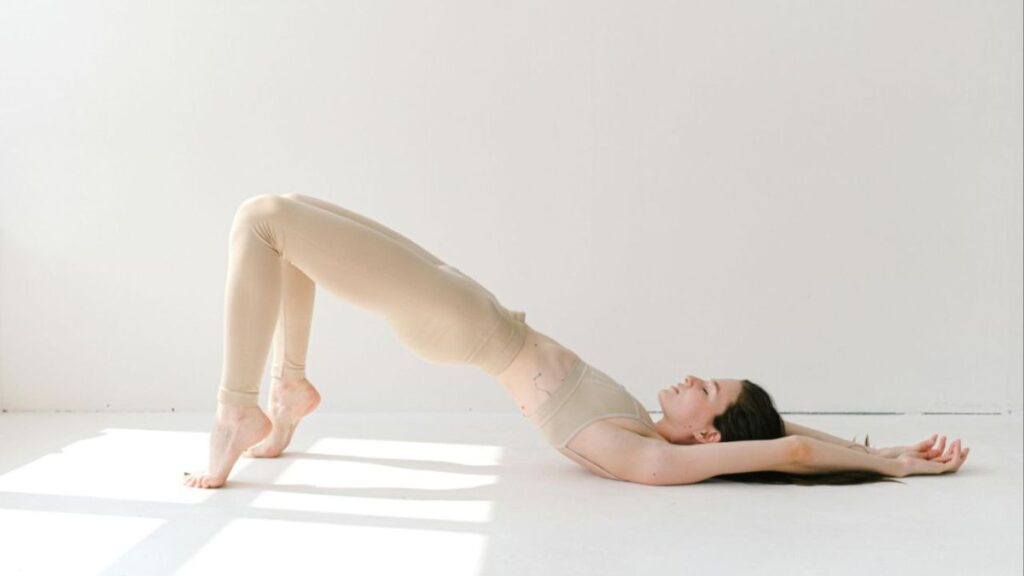Unlock Flexibility, Ease Tension, and Cultivate Mindful Movement
Stretching exercises are a simple yet powerful practice that anyone can start, regardless of fitness level. It’s not just for athletes or those who want to become more flexible—stretching is beneficial for everyone. It improves the range of motion, eases tension, enhances circulation, and supports relaxation. This guide offers a comprehensive look into beginner-friendly stretches you can do at home, in the office, or as part of a workout routine.
Why Stretching Exercises is Important for Beginners
Starting a stretching routine is one of the best things you can do for your body and mind. Here’s why:
- Improves Flexibility and Range of Motion: Over time, regular stretching helps your muscles lengthen and adapt, allowing for greater flexibility.
- Reduces Muscle Tension: Stretching provides relief from muscle stiffness, especially after sitting for long periods or after a workout.
- Enhances Posture and Alignment: With targeted stretches, you can reduce muscle imbalances that contribute to poor posture.
- Increases Circulation: Stretching boosts blood flow to muscles, which helps in recovery and makes you feel more energized.
- Promotes Relaxation: Stretching exercises, when combined with deep breathing, can help relax the nervous system, reduce stress, and improve mental well-being.
Simple, Effective Stretches to Get Started
These stretches target major muscle groups without requiring advanced flexibility. Choose a few to begin with, or try them all as part of a routine.
1. Standing Calf Stretch

Target Muscles: Calves
How to Do It: Stand facing a wall or another solid surface. Place your hands on it for balance. Step one foot back, turning the toes of that foot slightly inward, and press your heel firmly into the floor. Bend your front knee slightly, keeping the back leg straight.
Focus on the Breath: Breathe deeply as you feel the stretch through the calf of the back leg.
Modification: To increase the intensity, move the back foot farther away from the wall and press down through the heel.
Benefits: This stretch improves ankle flexibility, eases tension in the calves, and can help prevent foot and ankle injuries.
2. Inner Thigh Stretch

Target Muscles: Inner Thighs
Options: Seated or Standing
Standing Version: Start with feet wider than hip-width apart, toes pointing forward. Shift your weight to one side, bending one knee and keeping the other leg straight. Lean your upper body slightly forward as you feel the stretch in the inner thigh of the straight leg.
Seated Version: Sit on a chair or stability ball with one leg bent and the other extended sideways. Lean toward the bent leg until you feel a gentle stretch along the inner thigh of the extended leg.
Benefits: This stretch helps open up the hip area, which can relieve tension and improve flexibility, especially if you spend a lot of time sitting.
3. Hamstring Stretch

Target Muscles: Hamstrings
Options: Seated or Standing
Standing Version: Stand with feet hip-width apart. Extend one leg forward, heel down and toes pointed up. Bend your other knee slightly and hinge at the hips, reaching toward your toes. Keep your back straight as you stretch the back of the extended leg.
Seated Version: Sit at the edge of a chair with both knees bent. Straighten one leg, placing the heel on the floor. Lean forward from the hips, reaching toward the toes.
Benefits: Hamstring stretches are key to preventing tightness in the lower back and legs, making movements more fluid.
4. Quadriceps Stretch

Target Muscles: Quadriceps (front thigh)
Options: Standing or Lying Down
Standing: Hold onto a chair or wall for support. Bend one knee, grab your ankle or foot, and pull it gently toward your glutes. Keep the knees close together and engage your core to maintain balance.
Lying Down: Lie on your side with both legs extended. Bend the top leg and pull it toward your glutes, holding your foot or ankle.
Benefits: This stretch can improve balance and is particularly beneficial for anyone experiencing tightness in the front of the thighs or hip flexors, often due to sitting.
5. Hip Flexor Stretch

Target Muscles: Hip Flexors
Options: Kneeling or Standing
Kneeling: Start in a half-kneeling position with one knee on the floor and the other foot forward, knee bent at 90 degrees. Engage the glutes on the side of the leg that is down and gently push your hips forward.
Standing: Step one foot back and reach the opposite arm overhead, rotating the torso gently to feel a stretch along the front of the hip and thigh.
Benefits: Stretching the hip flexors improves hip mobility, reduces lower back pain, and helps balance the body if you sit often. For stretching exercises
Upper Body and Spine Stretches
6. Lat Stretch
Target Muscles: Lats (back)
How to Do It: Stand facing a wall or chair. Place both hands on the surface, about shoulder-width apart. Step back and hinge at the waist, bringing your chest down toward the floor. You should feel a stretch along the sides of your body.
Benefits: This stretch releases tension in the upper back and shoulders, which can be beneficial for posture.
7. Chest Stretch
Target Muscles: Chest, Shoulders
How to Do It: Stand near a doorway. Bend your elbow at 90 degrees and place your forearm against the doorframe at shoulder height. Step forward slightly to feel a stretch across your chest and shoulder.
Benefits: This stretch helps open up the chest and shoulders, promoting better posture and reducing tightness from sitting.
8. Trapezius and Neck Stretch
Target Muscles: Neck, Shoulders
How to Do It: Sit or stand with shoulders relaxed. Place one hand on top of your head and gently pull your head toward one shoulder to stretch the side of your neck.
Benefits: This stretch relieves tension in the neck and shoulders, which is beneficial if you spend a lot of time on a computer or smartphone.
Creating a Consistent Stretching Routine
For beginners, it’s important to start slow and build consistency. Stretching a few days per week is a great way to begin, eventually working up to a daily routine if it feels good.
- Frequency: Aim to stretch at least 2-3 times per week for flexibility and muscle relaxation. Once comfortable, try daily stretching for optimal results.
- Timing: Stretch when your muscles are warm—after a workout, during a break from sitting, or in the evening to wind down.
- Hold and Relax: For each stretch, hold for at least 15-30 seconds, and up to 2 minutes for deeper stretches. Focus on relaxing into each stretch and breathing deeply.
- Adapt to Your Needs: Choose stretches that target areas where you feel tight or sore. Adapt them as necessary to suit your level of flexibility and comfort.
Tips to Enhance Your Stretching Exercises Experience
Focus on Your Breathing: Slow, deep breaths help relax your body and make stretches more effective. Exhale as you deepen the stretch, and inhale as you hold.
Be Gentle: Stretching should feel comfortable and enjoyable. Avoid pushing yourself into pain or discomfort.
Stay Consistent: Consistency is key. Even 5-10 minutes daily can make a difference in how your body feels.
Combine Stretching exercises with Movement: Stretching alongside activities like yoga, walking, or light strength training can improve mobility.
Final Thoughts
A beginner-friendly stretching exercises routine can be a great addition to your daily life, enhancing flexibility, relieving tension, and supporting overall health. With these stretches, you’ll be on your way to improved mobility and relaxation in no time. Keep exploring and adjusting to your body’s needs, and remember that stretching is a journey, not a destination.
Some FAQ
All these stretches can be done daily, and you will notice improvements in your flexibility by stretching more regularly. If you have a desk job or spend most of your day seated (like most people), there are some stretches that you can do periodically throughout your day to improve your posture and reduce lower back pain.
No! There’s no risk in stretching every day unless you’re stretching too far. When you sink into a stretch position, you want to stop when you begin to feel the tension. If you experience pain or the stretch is extremely uncomfortable, you might be stretching beyond your body’s capability.
If this happens, stop and reposition to find the spot where you feel tension in the stretch. Also, if you have an injury, you will want to check with your physician before starting a stretch routine to ensure that the stretching is helping and not harming you.
How often should you stretch? As long as you’re not overdoing it, the more regularly you stretch, the better it is for your body. It’s better to stretch for a short time every day or almost every day instead of stretching for a longer time a few times per week.
A lot of people don’t understand that stretching has to happen on a regular basis. Ideally, it should be daily.
The best time and place to do nighttime stretches is whenever and wherever you’ll do them consistently. Plan to stretch around 30 minutes to an hour before bedtime. “If you wait until the last minute when you’re too tired, you’ll be more likely to skip





[…] through low-impact exercises like Tai Chi. These exercises focus on slow, controlled movements that enhance flexibility, balance, and strength without putting unnecessary strain on your […]
[…] be tricky. Should you go for a treadmill to simulate outdoor running? Or maybe an elliptical for a low-impact, full-body workout? Choosing the right equipment depends on several factors, including your fitness […]
[…] Master these movements with proper form, and you’ll notice significant improvements in strength, posture, and injury resilience. Whether you’re a gym novice or an experienced lifter, incorporating horizontal pull patterns is essential for a balanced and powerful physique! […]